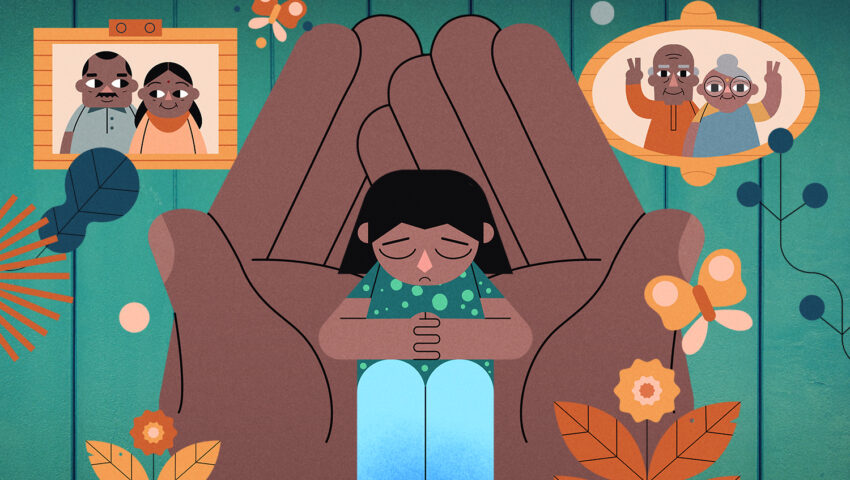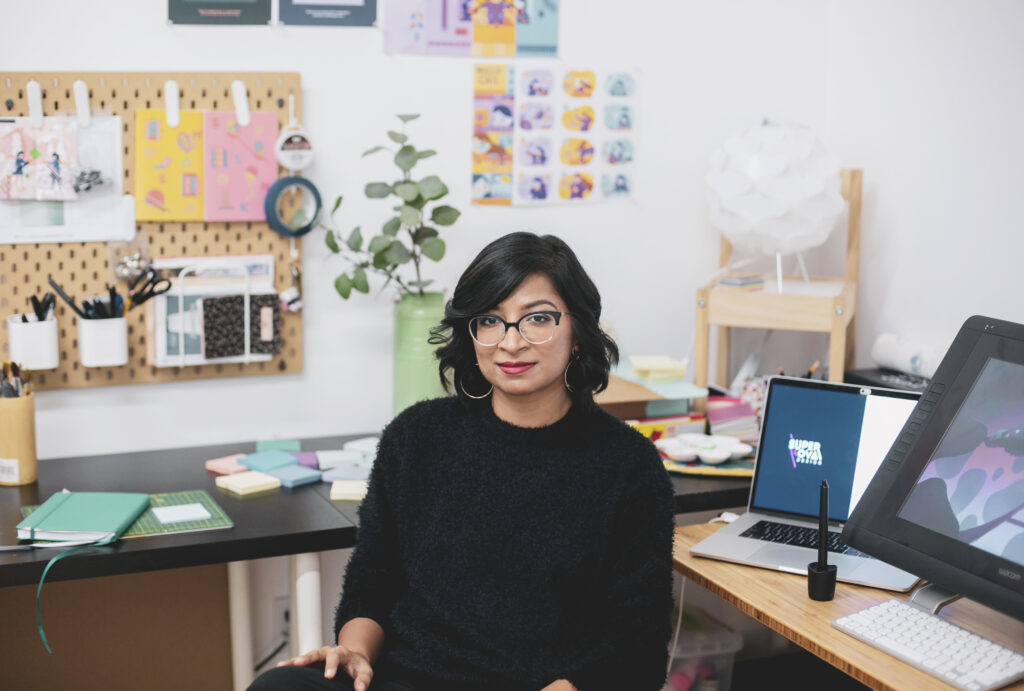“A New Normal” © 2020 SUPERNOVA DESIGN INC. All rights reserved
Sometimes it’s best to think inside the box — “A New Normal“, presented at SIGGRAPH 2021, is a short film that was created using augmented reality. The film subverts the limitations of digital intimacy to create a story about warmth, hope, and family. We connected with creator Asavari Kumar to discuss the serendipitous journey that led her to create her film during the pandemic. Learn about the highs and lows that she faced and how having less control of a project can lead to amazing discoveries.
SIGGRAPH: Share some background about “A New Normal”. What inspired the project and how did you come to learn about Adobe’s Festival of the Impossible for which you developed it?
Asavari Kumar (AK): Toward the end of 2019, I was quite curious about taking storytelling into new mediums. I started looking into [whether] there [were] any programs and workshops when I came across a residency that encouraged people who tend to work with more traditional 2D mediums — such as illustration design, animation, and Adobe software — to take on this new AR program called Adobe Aero. This program can help artists push themselves to explore a spatial and site-specific medium, depending on the type of work that people want to develop and incorporate into their regular creative practice. I thought the residency was an interesting jumping off point and it gave me the chance to experiment.
Toward the end of my residency, the curator told us that we were going to have a festival with the idea to pitch a more formal project using Adobe Aero. I was excited because it allowed me to mix other mediums, use my personal experiences, and thread them into stories that have universal resonance.
During the middle of my residency, the pandemic kicked off and the festival moved to virtual, so I figured, why not make a film since it wasn’t necessary to have a full in-person AR experience. By using the space available to me, I developed a film using AR with my evolving understanding of home and belonging as the subject matter. I have been stuck in the immigration process for about five to six years, so I wasn’t able to leave the country and visit my family in India in a very long time and the pandemic helped prolong that. I used my film as a grieving process and I felt like many people may have had a similar experience during the pandemic. During this time, everyone is dependent on talking to their loved ones almost exclusively through the phone and overly reliant on digital communication.
The theme of the Festival of the Impossible had to do with home identity and belonging, I wanted to reframe the idea of home through the eyes of my family and explores how it evolves over time.
SIGGRAPH: Break down why augmented reality was the right medium for creating “A New Normal”. In addition to Adobe Aero, what other tech tools were involved? What was the end goal of the story and how do you hope the project can inspire others moving forward?
AK: As a creator, on one hand, you want freedom, but on the other hand, limitations of different kinds force you to be creative. It was an oddly serendipitous situation where the lockdown restrictions limited me to use the available spaces, like my apartment or my art studio, because it wasn’t safe to go anywhere else during the pandemic. I felt this worked perfectly because my story had to do with these personal intimate spaces and the idea of my family coming into my home and the life that I’ve established for myself. I liked the idea of using some medium to create an enhanced or an augmented reality, one which doesn’t exist – it’s something that you do in animation anyway. Since this project was tied to my physical place of being augmented reality became the perfect medium to then explore those ideas.
This particular story worked because all the limitations sort of came together to give the narrative structure. From a conceptual viewpoint, I believe there should always be a reason behind why you use a certain medium to tell a certain story. And because of these reasons and the limitations we had, and a story exploring physical spaces we can and cannot inhabit, augmented reality became the perfect medium to transform those spaces.
Since this was my first foray into augmented reality, I liked that Adobe Aero is constructed in a way that allows you to jump into it and run with it. It does not have any sort of technical layer that pushes you away or makes it an inaccessible medium. It felt really fluid and very intuitive.
The end goal of this story was pretty much the end goal of every story that I tell: to offer my perspective and hope that others find resonance with it, and if someone feels like they’re the only one going through a certain experience, it can make them feel less alone. We see this medium being used in games, retail, and marketing, but I haven’t seen a whole lot of AR storytelling. So I think one of the reasons I wanted to put this out there was to show creators that if you have a lot of limitations, AR is actually a wonderful medium to break those limitations and transform things that are available to you, and maybe add in new dimensions and context.
Sometimes polished, highly rendered work can take away from the rawness of creation. The handmade quality of the AR medium really is something I enjoyed about this process because it felt very intuitive and spontaneous to create. Anytime you spend a long time in production, you start to lose that initial spark of your idea, so I feel like AR mixes the aspects of animation and documentary filmmaking processes while reducing the production time. This immediacy is important when you’re telling personal stories, so you can capture and express them with more authenticity.
SIGGRAPH: What has it been like keeping your social and family connections alive amidst the pandemic? Do you believe we rely too much on digital conversations?
AK: At this point, I don’t see any alternatives. We are relying on it a lot, but it definitely does not replace what an in-person connection can do for you. Being able to create something together is more important than exclusively living in the digital space. I work with my sister a lot, she’s my creative partner for Supernova Design, which is our studio, yet she lives in Copenhagen and I live in Los Angeles. For us, if we didn’t have digital media we wouldn’t be connected to each other, nor would we be able to create things together. Whether or not you are a professional creator, the act of co-creation really adds value to a digital connection versus being connected for the sake of connection.
I have a weird relationship with digital media. There are aspects that I find troubling, but if it didn’t exist, I wouldn’t be able to talk to my family or have meaningful interactions. It’s important to be aware of the pros and cons of every medium and to use it more consciously, but I don’t think any means of communication is free from its perils.
SIGGRAPH: How do you envision augmented reality and real-time compositing being used in future AR projects?
AK: When I was in school, I came across a project that this Japanese research lab was doing where they were trying to feed images into a database and then associate certain images with data from someone’s sleep patterns. Almost like printing out someone’s dreams. There was something about that immediacy of documentation in that experiment that I found quite compelling. Similarly, AR can be an amazing medium to document something in your own, unique voice and it can be a way to empower people to tell their own stories. Many minority groups that don’t have a lot of access rarely have their stories seen or heard. I hope this project will empower individuals who are not used to telling their stories and I hope that real-time compositing and AR can become accessible enough to allow people to offer their own perspectives with more authenticity.
SIGGRAPH: What challenges did you face while developing the final experience you presented to the SIGGRAPH community?
AK: One of my biggest challenges was the fact that some features in the app were still in development, so there was a lot that I initially wanted to do that I couldn’t, including animation. That is now available but at the time I could only use images. So, my biggest challenge was working with still imagery and trying to approach it less like a film and more like a storybook. This was a big shift because I had to make imagery compelling enough to work without motion and match it to audio to make sure it was enough material for the audience to understand the narrative that’s unfolding. It was an interesting challenge, again it was a limitation that ended up working quite well by reframing how I should be looking at the story because there are so many different ways to tell a story through so many different mediums.
The other challenge was shifting from a heavy pre-production, very controlled way of working, which is what animation brings to the table. You have so much control in animation, so you tend to lean into that and want to control every single aspect, but there were so many happy little accidents in the AR process where things didn’t go as planned. You go in thinking that this scene is going to be really weird but here’s this other space in which it works really well, so it was this shift in mindset that I initially found challenging but it ended up being quite liberating. Once I gave up control of what this was going to be, it started taking on a life of its own. After that, it became a lot easier to move forward with our process. In addition to relinquishing control, since the app was still in development, there were a lot of additional technical challenges with the video resolution and the number of assets you could put into a scene so I had to manage my expectations.
SIGGRAPH: What advice do you have for someone who wants to submit to a future SIGGRAPH conference?
AK: Make whatever you want to make and craft something only you can create – I think that makes for compelling work. SIGGRAPH is a space where I feel exploration and experimentation are encouraged. If you’re trying something in a new medium or using existing technology in an interesting way, putting that together with your unique voice, can be a great way to approach a project.
Asavari Kumar is a director and visual artist from India, currently based in Los Angeles. Her award-winning films and new media work have been showcased at numerous festivals, including the Ottawa International Animation Festival and SIGGRAPH. Drawn to cross-cultural narratives, Asavari uses character-driven storytelling to parse her evolving cultural and political identity. Asavari is the co-founder of Supernova Design and holds an MFA in experimental animation from the California Institute of the Arts.












Leave a Reply